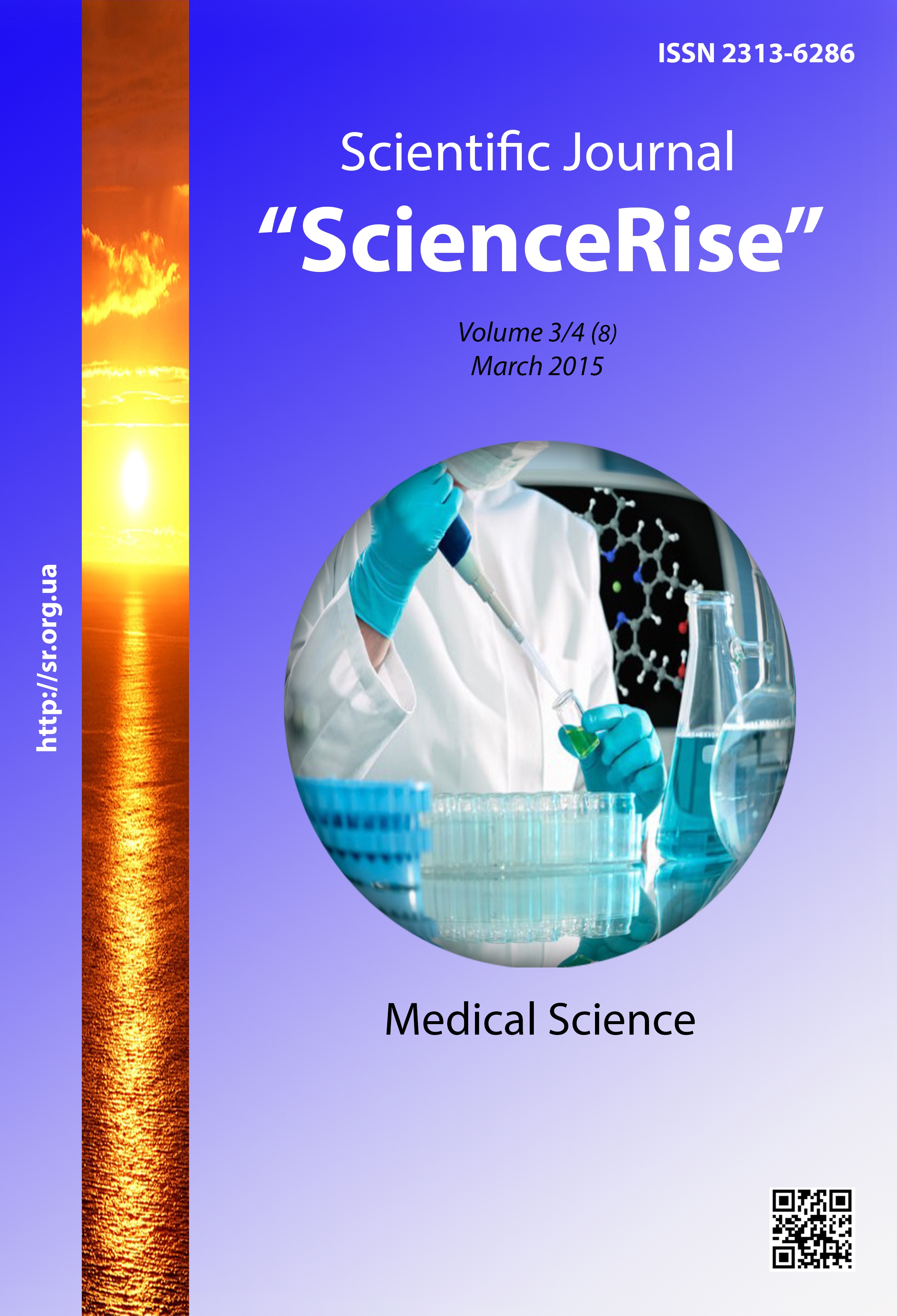Использование различных методов вертикальной и горизонтальной аугментации при атрофии альвеолярного отростка верхней и альвеолярной части нижней челюстей
DOI:
https://doi.org/10.15587/2313-8416.2015.39313Ключові слова:
атрофия кости, дентальная имплантация, костная аугментация, костный блок, синус-лифтингАнотація
Основной проблемой дентальной имплантации, является недостаточное количество кости. Однозначного решения проблемы атрофии не существует. Выбор метода остеопластики и трансплантата зависит от точного определения степени атрофии костной ткани, характера и размеров дефекта.
На клинических примерах продемонстрированы методы восстановления объема кости верхней и нижней челюстей с использованием трансплантатов различного происхождения
Посилання
Ackermann, K.-L., Wenz, B. (2004). Laterale Kammaugmentationen mit Blocktransplantaten und Konturierung mit Knochenersatz. Fallpräsentationen Implantologie, 12 (2), 177–189.
Smbatjan, B. S. (2012). Vosstanovlenie kostnoj tkani pri lechenii pacientov s ispol'zovaniem dental'nyh implantatov v razlichnyh klinicheskih situacijah. Moscow, 26.
Razmyslov, A. V. (2011). Optimizacija hirurgicheskoj taktiki pri zameshhenii kostnyh defektov i uvelichenii razmerov atrofirovannyh al'veoljarnogo otrostka verhnej cheljusti i al'veoljarnoj chasti nizhnej cheljusti. Moscow, 26.
Hatit, R. A. (2013). Diagnosticheskie vozmozhnosti komp'juternoĭ tomografii pri planirovanii ortopedicheskogo lechenija na implantatah. 3D-hirurgicheskiĭ shablon. X-Ray Art, 2 (01), 46–48.
Montesani, L., Späte, U. S., Dibart, S. (2011). Sinus augmentation in two patients with severe posterior maxillary height atrophy using tissue-engineered bone derived from autologous bone cells: A case report. Int. J. Oral Maxillofac. Implants, 31, 391–399.
Al-Khaldi, N., Sleeman, D., Allen, F. (2011). Stability of dental implants in grafted bone in the anterior maxilla: longitudinal study. British Journal of Oral and Maxillofacial Surgery, 49 (4), 319–323. doi: 10.1016/j.bjoms.2010.05.009
Nyström, E., Nilson, H., Gunne, J., Lundgren, S. (2009). Reconstruction of the atrophic maxilla with interpositional bone grafting/Le Fort I osteotomy and endosteal implants: A 11–16 year follow-up. International Journal of Oral and Maxillofacial Surgery, 38 (1), 1–6. doi: 10.1016/j.ijom.2008.10.009
Chappard, D., Guillaume, B., Mallet, R., Pascaretti-Grizon, F. (2010). Sinus lift augmentation and β-TCP: A microCT and histologic analysis on human bone biopsies. Micron, 41 (4), 321–326. doi: /10.1016/j.micron.2009.12.005
van der Mark, E. L., Bierenbroodspot, F., Baas, E. M., Jan de Lange (2011). Reconstruction of an atrophic maxilla: comparison of two methods. British Journal of Oral and Maxillofacial Surgery, 49 (3), 198–202. doi: 10.1016/j.bjoms.2010.03.001
McNamara, I. R., Rayment, A., Brooks, R., Best, S. et al. (2012). The effect of the addition of hydroxyapatite graft substitutes upon the hoop strain and subsequent subsidence of a femoral model during impaction bone 40 grafting. Journal of the Mechanical Behavior of Biomedical Materials, 5 (1), 238–246. doi: 10.1016/j.jmbbm.2011.08.027
Kirilova, I. A., Sadovoj, M. A., Podorozhnaja, V. T. (2012). Sravnitel'naja harakteristika materialov dlja kostnoj plastiki: sostav i svojstva. Hirurgija pozvonochnika. Jeksperimental'nye issledovanija, 3, 72–83.
Hee, C. K., Dines, J. S., Dines, D. M., Roden, C. M. et. al. (2011). Augmentation of a Rotator Cuff Suture Repair Using rhPDGF-BB and a Type I Bovine Collagen Matrix in an Ovine Model. The American Journal of Sports Medicine. 39 (8), 1630–1639. doi: 10.1177/0363546511404942
Zakhary, I. E., El-Mekkawi, H. A., Elsalanty, M. E. (2012). Alveolar ridge augmentation for implant fixation: status review. Oral Surgery, Oral Medicine, Oral Pathology and Oral Radiology, 114 (5), S179–S189. doi: 10.1016/j.oooo.2011.09.031
Trautvetter, W., Kaps, C., Schmelzeisen, R., Sauerbier, S. et al. (2011). Tissue-Engineered Polymer-Based Periosteal Bone Grafts for Maxillary Sinus Augmentation: Five-Year Clinical Results. Journal of Oral and Maxillofacial Surgery, 69 (11), 2753–2762. doi: 10.1016/j.joms.2011.02.096
Majorana, K., Simion, M. (2005). Peredovye metodiki regeneracii kosti s Bio-Oss i Bio-Gajd. Moscow: «Azbuka», 104.
Jepple, M. (2007). Biomaterialy i biomineralizacija. Tomsk, «Veter», 137.
##submission.downloads##
Опубліковано
Номер
Розділ
Ліцензія
Авторське право (c) 2015 Анатолий Георгиевич Гулюк, Сурен Диасович Варжапетян, Сергей Анатольевич Гулюк, Армен Эдуардович Тащян, Владлен Владимирович Лепский, Сергей Анатольевич Гулюк, Владлен Владимирович Лепский, Армен Эдуардович Тащян, Владлен Владимирович Лепский

Ця робота ліцензується відповідно до Creative Commons Attribution 4.0 International License.
Наше видання використовує положення про авторські права Creative Commons CC BY для журналів відкритого доступу.
Автори, які публікуються у цьому журналі, погоджуються з наступними умовами:
1. Автори залишають за собою право на авторство своєї роботи та передають журналу право першої публікації цієї роботи на умовах ліцензії Creative Commons CC BY, котра дозволяє іншим особам вільно розповсюджувати опубліковану роботу з обов'язковим посиланням на авторів оригінальної роботи та першу публікацію роботи у цьому журналі.
2. Автори мають право укладати самостійні додаткові угоди щодо неексклюзивного розповсюдження роботи у тому вигляді, в якому вона була опублікована цим журналом (наприклад, розміщувати роботу в електронному сховищі установи або публікувати у складі монографії), за умови збереження посилання на першу публікацію роботи у цьому журналі.

